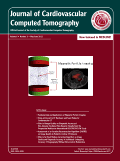
Journal of Cardiovascular Computed Tomography
Scope & Guideline
Shaping the dialogue in cardiovascular research and practice.
Introduction
Aims and Scopes
- Cardiovascular Imaging Techniques:
The journal publishes studies on various cardiovascular imaging modalities, particularly focusing on advancements in computed tomography and its applications in assessing coronary artery diseases, structural heart conditions, and other cardiovascular anomalies. - Clinical Applications and Outcomes:
Research articles often explore the clinical implications of CT findings, aiming to correlate imaging results with patient outcomes, treatment strategies, and prognostic indicators. - Technological Innovations:
A significant focus is placed on new technologies, including artificial intelligence and machine learning applications in CT imaging, which enhance diagnostic accuracy and efficiency. - Quantitative Imaging and Biomarkers:
The journal emphasizes quantitative imaging techniques to assess atherosclerotic plaque burden, myocardial perfusion, and other cardiovascular parameters, alongside the exploration of biomarkers derived from imaging data. - Interventional Cardiology:
There is a dedicated section on the role of CT in guiding interventional procedures, such as transcatheter aortic valve replacement (TAVR) and percutaneous coronary interventions.
Trending and Emerging
- Artificial Intelligence in Imaging:
The integration of AI and machine learning techniques in CT imaging is gaining traction, with numerous studies exploring their potential to improve diagnostic accuracy, automate image analysis, and predict cardiovascular events. - Quantitative Assessment of Plaque Characteristics:
There is an increasing emphasis on the quantitative measurement of plaque characteristics using CT, focusing on their relationship to clinical outcomes and the development of novel scoring systems. - Personalized Medicine Approaches:
Emerging themes include the application of personalized medicine in cardiovascular imaging, where patient-specific factors and imaging results are used to tailor treatment strategies, particularly in complex cases like coronary artery disease. - Interventional Guidance and Planning:
The role of CT in pre-procedural planning for interventions, such as TAVR and coronary interventions, is increasingly highlighted, showcasing its importance in improving procedural outcomes. - Cardiovascular Risk Stratification:
Recent studies are focusing on using CT-derived metrics for better risk stratification in various populations, including those with non-obstructive coronary artery disease, enhancing the predictive power of imaging.
Declining or Waning
- Traditional Coronary Angiography Comparisons:
There has been a noticeable reduction in studies directly comparing traditional invasive coronary angiography with CT angiography, as the latter becomes more established and accepted in clinical practice. - Basic Anatomy Studies:
Research focusing solely on the anatomical aspects of coronary structures is less prevalent, indicating a shift towards more functional and outcome-based studies that integrate imaging with clinical implications. - Generalized Risk Factor Assessment:
The journal seems to be moving away from broad studies on traditional cardiovascular risk factors in isolation, favoring more nuanced approaches that incorporate imaging findings and specific patient populations.
Similar Journals

Cardiovascular Intervention and Therapeutics
Advancing cardiovascular care through innovative research.Cardiovascular Intervention and Therapeutics, published by SPRINGER JAPAN KK, stands as a prominent journal within the fields of cardiology and cardiovascular medicine, reflecting its commitment to disseminating groundbreaking research and clinical advances. With an impressive Q2 ranking in Cardiology and Cardiovascular Medicine as well as in Medicine (miscellaneous), and a Q1 ranking in Radiology, Nuclear Medicine and Imaging, this journal employs rigorous peer-review processes to ensure the quality and relevance of its content. Catering to a diverse audience of researchers, clinicians, and students, the journal aims to foster innovation and enhance understanding through the publication of original research, reviews, and clinical studies focused on cardiovascular interventions and therapies. Spanning over a decade of evolution from 2010 to 2024, Cardiovascular Intervention and Therapeutics continues to be a vital resource for advancing knowledge and practice in the cardiovascular field. Explore the latest advancements and insights that this esteemed journal has to offer, and contribute to the ongoing dialogue that shapes modern cardiovascular medicine.
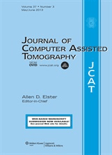
JOURNAL OF COMPUTER ASSISTED TOMOGRAPHY
Enhancing Radiology with Cutting-Edge ResearchJOURNAL OF COMPUTER ASSISTED TOMOGRAPHY, published by Lippincott Williams & Wilkins, stands as a vital resource in the field of Radiology, Nuclear Medicine, and Imaging. Since its inception in 1977, this journal has been dedicated to advancing the understanding and application of computer-assisted tomography, emphasizing innovative research and clinical practices that enhance diagnostic imaging techniques. With an impact factor reflective of its rigorous scholarship and relevance—ranking in the Q3 category—the journal serves as an essential platform for contributors and readers alike, navigating the challenges and opportunities within a rapidly evolving field. Researchers, professionals, and students are encouraged to engage with the rich repository of articles that cover emerging technologies, clinical applications, and theoretical advancements, collectively fostering a deeper comprehension of imaging sciences. Although not currently designated as an open-access journal, it continues to enhance discourse in the community from its headquarters in Philadelphia, PA, maintaining a commitment to the highest standards of academic excellence.
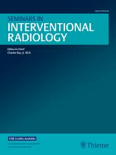
SEMINARS IN INTERVENTIONAL RADIOLOGY
Fostering Collaboration in Cardiovascular ResearchSEMINARS IN INTERVENTIONAL RADIOLOGY, published by Thieme Medical Publishers Inc, is a pivotal peer-reviewed journal in the fields of interventional radiology, cardiology, and cardiovascular medicine. With a legacy spanning from 1984 to 2024, this journal serves as an essential resource for professionals seeking to advance their understanding of minimally invasive procedures and imaging techniques. Although it operates under a non-open access model, SEMINARS IN INTERVENTIONAL RADIOLOGY is committed to disseminating high-quality research and clinical insights, thus contributing to ongoing developments in effective medical practices. It enjoys a respectable position within the academic community, indicated by its 2023 rankings of Q3 in both cardiology and radiology categories, reflecting its relevance and influence in the respective fields. This journal not only addresses current trends and challenges but also aims to foster collaboration among researchers and clinicians, emphasizing the importance of evidence-based practices in improving patient outcomes.
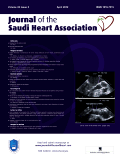
Journal of the Saudi Heart Association
Pioneering Insights in Cardiovascular Medicine Since 2009The Journal of the Saudi Heart Association is a prominent scholarly publication dedicated to advancing knowledge in the fields of cardiology and cardiovascular medicine. Published by DIGITAL COMMONS BEPRESS, this open-access journal has been serving the global community since 2009, providing a vital platform for researchers, practitioners, and students interested in the latest developments in heart health and disease management. With an ISSN of 1016-7315 and a growing repository of knowledge alongside an E-ISSN of 2212-5043, the journal showcases an array of peer-reviewed articles that contribute to the understanding of cardiovascular conditions. Although categorized in the Q4 quartile for 2023, it remains committed to offering valuable insights, particularly within the constraints of the 29th percentile rank specified by Scopus. As the journal converges towards 2024, it continues to foster collaboration, innovation, and inquiry within the Saudi Arabian and international medical communities.
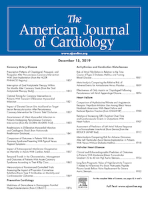
AMERICAN JOURNAL OF CARDIOLOGY
Elevating Standards in Cardiovascular Research and PracticeThe American Journal of Cardiology is a leading peer-reviewed journal in the field of Cardiology and Cardiovascular Medicine, published by Excerpta Medica Inc-Elsevier Science Inc. Since its inception in 1958, the journal has consistently contributed to the advancement of cardiovascular research, providing a platform for groundbreaking studies and clinical findings that shape modern medical practices. With an impressive impact factor placing it in the Q1 category in its field for 2023, it ranks among the top journals in medicine, with a rank of #155 out of 387 in the Scopus database, reflecting its significance and rigorous editorial standards. The journal is committed to disseminating high-quality research that fosters innovation and enhances clinical outcomes in cardiology. Although it does not provide Open Access options, the American Journal of Cardiology remains an essential resource for researchers, healthcare professionals, and students looking to deepen their understanding of cardiovascular health.

INTERNATIONAL JOURNAL OF CARDIOVASCULAR IMAGING
Advancing the Frontiers of Cardiovascular ImagingINTERNATIONAL JOURNAL OF CARDIOVASCULAR IMAGING, published by Springer, is a prestigious platform dedicated to the interdisciplinary field of cardiovascular medicine and imaging. With an ISSN of 1569-5794 and E-ISSN 1875-8312, the journal is recognized in both Cardiology and Cardiovascular Medicine (Rank #154/387, Q2 Category) and Radiology, Nuclear Medicine and Imaging (Rank #137/333, Q2 Category) disciplines, reflecting its significant impact within the scientific community. Established in 1988 and continuing to the present, it provides a rigorous forum for cutting-edge research, reviews, and clinical insights that are essential for advancing knowledge in cardiovascular diagnostics and therapeutic imaging. The journal's dual access options cater to both traditional and open-access readership, ensuring wide dissemination of its findings. In an era where cardiovascular diseases pose a significant public health challenge, the INTERNATIONAL JOURNAL OF CARDIOVASCULAR IMAGING stands out as an essential resource for researchers, healthcare professionals, and scholars aiming to innovate and improve patient outcomes through imaging technology.

Heart Views
Advancing cardiovascular knowledge for a healthier tomorrow.Heart Views is a prestigious and influential journal dedicated to the field of cardiology and cardiovascular medicine, published by Wolters Kluwer Medknow Publications. With an Open Access model implemented since 2010, the journal ensures that its valuable research findings are accessible to a global audience, fostering knowledge dissemination and collaboration among researchers, professionals, and students alike. While the current impact factor is not specified, its commitment to quality and peer-reviewed content has established it as a significant resource within the cardiology community. The journal publishes a diverse array of articles, including original research, reviews, and clinical studies aimed at advancing the understanding and treatment of cardiovascular diseases. Heart Views serves as an essential platform for sharing innovative ideas and practices, thereby contributing to improved patient care and outcomes in the dynamic field of heart health.
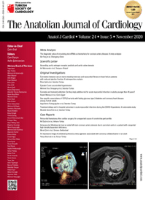
Anatolian Journal of Cardiology
Fostering Cardiovascular Excellence Since 2001.The Anatolian Journal of Cardiology, published by KARE PUBL, stands as a vital resource in the field of Cardiology and Cardiovascular Medicine. With an ISSN of 2149-2263 and E-ISSN 2149-2271, this Open Access journal has been fostering the dissemination of critical research since 2001, ensuring that high-quality content is freely available to a global audience. Based in Turkey, the journal aims to bridge gaps in cardiological knowledge through rigorous peer-reviewed articles that span a wide range of topics, from innovative clinical practices to groundbreaking research findings. While its current ranking places it in the Q3 category of cardiology journals, the Anatolian Journal of Cardiology continues to strive towards enhancing its impact, currently holding a Scopus rank of 236 out of 387. Researchers, practitioners, and students alike will find this journal an essential platform for keeping abreast of the latest developments in cardiovascular health.

REVISTA ESPANOLA DE CARDIOLOGIA
Fostering Excellence in Cardiovascular ResearchREVISTA ESPANOLA DE CARDIOLOGIA is a premier journal dedicated to the dynamic field of cardiology, published by EDICIONES DOYMA S A in Barcelona, Spain. With an impressive Q1 status in the Medicine (miscellaneous) category for 2023, this journal is recognized for its significant contributions to cardiovascular research, evidenced by its rank of #61 out of 387 in the Scopus database, placing it within the top 16% of journals in its field. Covering a broad range of topics within cardiology, the journal aims to disseminate high-quality research, clinical studies, and educational content, fostering knowledge sharing among researchers, clinicians, and students alike. While it does not currently offer open access, the journal maintains a commitment to advancing cardiovascular health through rigorous peer-reviewed articles. With a publication history that spans from 2013 to 2024, REVISTA ESPANOLA DE CARDIOLOGIA is an essential resource for those seeking to stay at the forefront of cardiology advancements and practices.
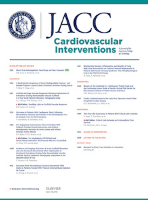
JACC-Cardiovascular Interventions
Unveiling the Future of Cardiac CareJACC: Cardiovascular Interventions is a premier journal dedicated to the field of cardiology and cardiovascular medicine, published by Elsevier Science Inc. This esteemed journal, with an ISSN of 1936-8798 and an E-ISSN of 1876-7605, has established itself as a leading platform for disseminating cutting-edge research and advancements from 2008 to the present, and is projected to continue until 2024. Recognized for its rigorous peer-review process and high-quality content, JACC: Cardiovascular Interventions holds a prestigious Q1 ranking in both Cardiology and Cardiovascular Medicine as well as a Q1 ranking in the broader category of Medicine (Miscellaneous) as of 2023. With a Scopus rank of #25 out of 387 in its field, placing it in the 93rd percentile, the journal is a vital resource for researchers, healthcare professionals, and students alike. Although it does not currently offer open access, its essential contributions to the medical community underscore its importance in advancing cardiovascular intervention knowledge and practice.